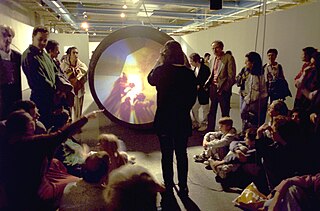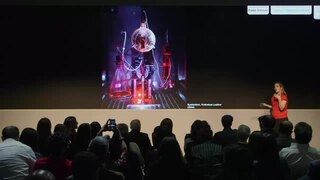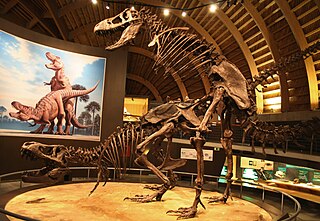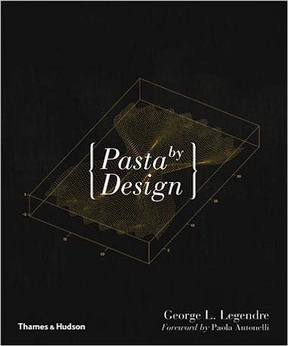
Interactive art is a form of art that involves the spectator in a way that allows the art to achieve its purpose. Some interactive art installations achieve this by letting the observer walk through, over or around them; others ask the artist or the spectators to become part of the artwork in some way.

In computing, a zooming user interface or zoomable user interface is a type of graphical user interface (GUI) where users can change the scale of the viewed area in order to see more detail or less, and browse through different documents. Information elements appear directly on an infinite virtual desktop, instead of in windows. Users can pan across the virtual surface in two dimensions and zoom into objects of interest. For example, as you zoom into a text object it may be represented as a small dot, then a thumbnail of a page of text, then a full-sized page and finally a magnified view of the page.
Critical design uses design fiction and speculative design proposals to challenge assumptions and conceptions about the role objects play in everyday life. Critical design plays a similar role to product design, but does not emphasize an object's commercial purpose or physical utility. It is mainly used to share a critical perspective or inspire debate, while increasing awareness of social, cultural, or ethical issues in the eyes of the public. Critical design was popularized by Anthony Dunne and Fiona Raby through their firm, Dunne & Raby.

The Sacco chair, is a large pear-shaped bag or sack made of leather or fabric and filled with expanded polystyrene foam pellets or a similar material. It is an example of anatomic design, as its form is determined by the user's body. The Sacco chair was designed by Piero Gatti, Cesare Paolini and Franco Teodoro in 1968, and became "one of the icons of the Italian anti-design movement. Its complete flexibility and formlessness made it the perfect antidote to the static formalism of mainstream Italian furniture of the period” according to design historian Penny Spark.

Achille Castiglioni was an Italian architect and designer of furniture, lighting, radiograms and other objects. As a professor of design, he advised his students "If you are not curious, forget it. If you are not interested in others, what they do and how they act, then being a designer is not the right job for you."

Paola Antonelli is an Italian architect, curator, author, editor, and educator. Antonelli is the Senior Curator of Architecture and Design at the Museum of Modern Art (MoMA), New York, where she also serves as the founding Director of Research and Development. She has been described as "one of the 25 most incisive design visionaries in the world" by TIME magazine.
Eyebeam is a not-for-profit art and technology center in New York City, founded by John Seward Johnson III with co-founders David S. Johnson and Roderic R. Richardson.

Satyendra Pakhalé is an Indian designer, artist, industrial designer, and architect.
Dunne & Raby is a London-based design studio established 1994.

Exhibit design is the process of developing an exhibit—from a concept through to a physical, three-dimensional exhibition. It is a continually evolving field, drawing on innovative, creative, and practical solutions to the challenge of developing communicative environments that 'tell a story' in a three-dimensional space.

An exhibition, in the most general sense, is an organized presentation and display of a selection of items. In practice, exhibitions usually occur within a cultural or educational setting such as a museum, art gallery, park, library, exhibition hall, or World's fairs. Exhibitions can include many things such as art in both major museums and smaller galleries, interpretive exhibitions, natural history museums and history museums, and also varieties such as more commercially focused exhibitions and trade fairs. They can also foster community engagement, dialogue, and education, providing visitors with opportunities to explore diverse perspectives, historical contexts, and contemporary issues. Additionally, exhibitions frequently contribute to the promotion of artists, innovators, and industries, acting as a conduit for the exchange of ideas and the celebration of human creativity and achievement.
Hockett's Design Features are a set of features that characterize human language and set it apart from animal communication. They were defined by linguist Charles F. Hockett in the 1960s. He called these characteristics the design features of language. Hockett originally believed there to be 13 design features. While primate communication utilizes the first 9 features, the final 4 features are reserved for humans. Hockett later added prevarication, reflexiveness, and learnability to the list as uniquely human characteristics. He asserted that even the most basic human languages possess these 16 features.
Bzzzpeek.com is a website designed to appeal to young children that focuses on onomatopoeia from around the world. The site comprises recordings contributed by native speakers who imitate familiar sounds, such as animal calls and vehicle noises as they are typically rendered in their own language.

Hella Jongerius is a Dutch industrial designer.
Flavia Sparacino is an American-based space maker and scientist. She is currently CEO/Founder of Sensing Places, a MIT Media Lab spinoff that specializes in immersive space design and technology.
Matthew Kenyon is an American new media artist and director of the art practice, S.W.A.M.P.. Kenyon focuses on critical themes addressing global corporate operations, mass media, military-industrial complexes, and the liminal area between reality and artificial life.

Kacie Kinzer is an American designer and interactive artist. Her best known works are a series of cardboard "tweenbots", which were designed to get help from people, in order to complete their mission: crossing Washington Square Park. The bots were collected by the Museum of Modern Art and part of an exhibit on Design and Communication during 2011. Kinzer spoke at PopTech in 2009.
Listening Post is an artwork that visualizes Internet chatroom conversations. The work was created between 2002 and 2005 as a collaboration between the artist Ben Rubin and the statistician Mark Hansen.

Pasta by Design is a book by George L. Legendre, with a foreword by Paola Antonelli, and photography by Stefano Graziani. It is based on an idea by Marco Guarnieri.










